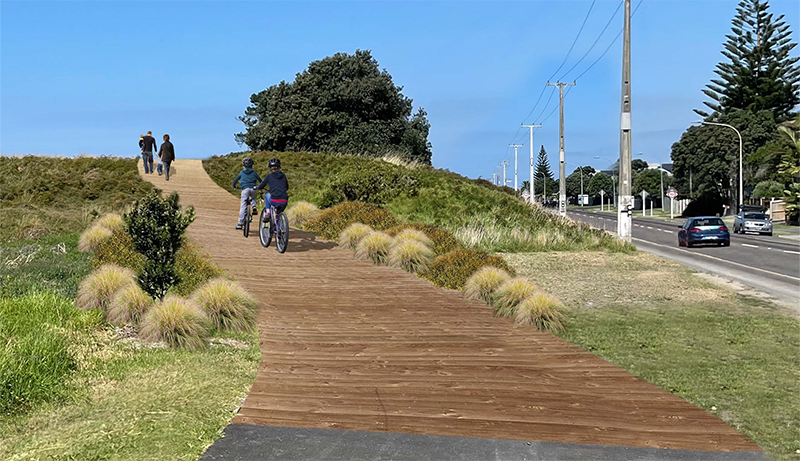Latest update
Construction of the new permanent pathway over the dunes on Pāpāmoa Beach Road, near Alexander Place, will begin the week of 21 October 2024.
As the dunes are ecologically protected, we required a new resource consent and Wildlife Act permissions to ensure we protect the area and fauna that live there. A lizard management plan was reviewed by the Department of Conservation who consulted with iwi, and a Wildlife Permit was granted in August 2024. The resource consent has also been issued. Work was not able to start until the lizard dormancy period finished at the end of September.
Building the boardwalk over the dunes involves a number of procedures to ensure we do it correctly.
Initially we will set the site up with traffic management, environmental controls and pre-site checks to ensure nesting birds are taken care of. Following this, there will be vegetation clearance along the alignment of the new boardwalk, and relocation of any fauna (lizards) that are found. Once the clearance work is complete, then construction of the new boardwalk can commence. This will also include planting and restoration of the areas of disturbed dune.
While construction of the new boardwalk over the dunes is taking place, there will be no roadside parking available opposite the works – from 680-708 Pāpāmoa Beach Road.
This work will be completed by February.
We will also be constructing four swales at the same time. The swales are designed to help with stormwater run-off from the road during high levels of rainfall and reduce flooding of Pāpāmoa Beach Road. These are located at low points along the shared pathway route:
- Area 1 – between Allan Place and Douglas Place
- Area 2 – near Simpson Reserve
- Area 3 – opposite the shops near Parton Road
- Area 4 – next to Grant Place.
Parking near the swale sites will be removed to assist with the traffic management set-ups, and for safer entry and exit of trucks and other work vehicles from the sites.
This work is anticipated to be finished before Christmas.

Artist's impression of the alternative route over the dunes heading west.
Key features of the shared pathway
The 3km asphalt pathway will make walking and cycling safer next to Pāpāmoa Beach Road and further enhances this reserve space.
During consultation, the community requested a sealed path to better meet the needs of a wide range of people, including children with scooters, people using wheelchairs, and people with roller blades. Asphalt is a commonly used material for sealed footpaths and is smooth service for people on wheels. It is highly durable and there are no health risks to the public, or to the environment, due to the material used. Other materials such as concrete and boardwalk have been used in rest areas and access ways.
The pathway provides ample width, with the 3.5m wide pathway designed to fit two people going each way. There are rest areas along the way and picnic tables at the two larger reserve areas.
The pathway will feature signage that shares the stories and history of mana whenua giving people the opportunity to reconnect and engage with this area of cultural significance. Artwork along the Pāpāmoa shared pathway was designed by Te Kapu O Waitaha and Ngā Pōtiki. The patterns have been placed along the pathway to identify beach accesses.
A whakataukī about Niho Taniwha, a kaitiaki (guardian), and a symbol of guardianship, trust and protection was the inspiration for both designs which serve as a reminder that we should all be considerate of one another when we’re using the shared path. Ngā Pōtiki's design is shown below on the left. Te Kapu O Waitaha’s design (pictured below-right) is based on Te Ara Moana which means pathways to the sea, waterways to many destinations.